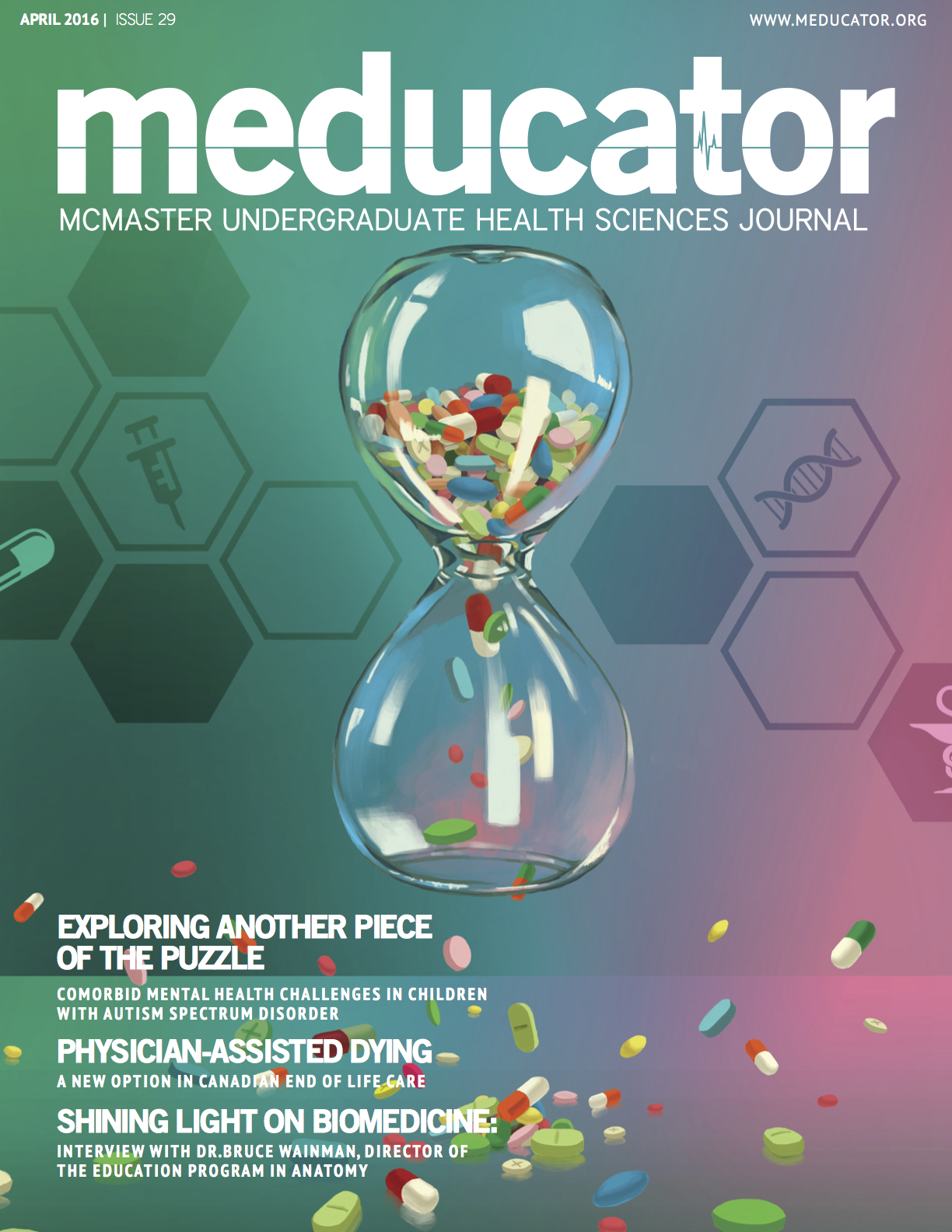Adderall and Ritalin: The New Caffeine?
DOI:
https://doi.org/10.15173/m.v1i29.1179Abstract
Long gone are the days of lost motivation and fatigue. Adderall and Ritalin, two types of cognitive enhancers normally prescribed for people with Attention Deficit Hyperactivity Disorder, are now being used by Canadian undergraduate students looking to increase their productivity in a progressively fast-paced world. Praising the perks while discounting the damages caused by the nonmedical ingestion of these drugs may lead individuals down a path of dependence with a flawed perception of success. To them, it is just like coffee, but treating these drugs as such is a recipe for harm. This report provides an overview of the current issues associated with the illegal ingestion of cognitive stimulants and attempts to uncover the benefits and consequences that may arise from their use.
References
Hosenbocus S, Chahal R. A review of long- acting medications for ADHD in Canada. J Can Acad Child Adolesc Psychiatry. 2009 Nov;18(4):331–9.
Government of Canada [Internet]. Canada: Government of Canada. Summary of results for 2013; 2015 Feb [cited 2016 Jan 28]. Available from: http://healthycanadians. gc.ca/science-research-sciences-recherch- es/data-donnees/ctads-ectad/summary- sommaire-2013-eng.php
American College Health Association. [In- ternet]. ACHA-NCHA II: Canadian reference group executive summary spring 2013. Hanover (MD): American College Health As- sociation; 2013 [cited 2016 Jan 28]. Avail- able from: http://www.cacuss.ca/_Library/ documents/ncha-II_web_spring_2013_ca- nadian_reference_group_executive_sum- mary.pdf
American College Health Association. [In- ternet]. ACHA-NCHA II: reference group executive summary spring 2013. Hanover (MD): American College Health Association; 2013 [cited 2016 Jan 28]. Available from http://www.acha-ncha.org/docs/acha-ncha- II_ReferenceGroup_ExecutiveSUmmary_ Spring2013.pdf
Desantis AD, Hane AC. “Adderall is definitely not a drug”: justifications for the illegal use of ADHD stimulants. Subst Use Misuse. 2010;45(1-2):31–46.
Elia J, Borcherding BG, Potter WZ, Mefford IN, Rapoport JL, Keysor CS. Stimulant drug treat- ment of hyperactivity: biochemical correlates. Clin Pharmacol Ther. 1990 Jul;48(1):57–66.
Madras BK, Miller GM, Fischman AJ. The dopamine transporter and attention-deficit/ hyperactivity disorder. Biol Psychiatry. 2005;57(11):1397–409.
Wilens TE. Effects of methylphenidate on the catecholaminergic system in attention-defi- cit/hyperactivity disorder. J Clin Psychophar- macol. 2008 Jun;28(3 Suppl 2):S46–53.
Lakhan SE, Kirchgessner A. Prescription stimulants in individuals with and without at- tention deficit hyperactivity disorder: misuse, cognitive impact, and adverse effects. Brain Behav. 2012 Sep;2(5):661–77.
Ilieva, I. P., & Farah, M. J. Enhancement stimulants: perceived motivational and cog- nitive advantages. Front Neurosci. 2013 Oct;7(198):1-6.
IlievaI,BolandJ,FarahMJ.Objectiveandsub- jective cognitive enhancing effects of mixed amphetamine salts in healthy people. Neuro- pharmacology. 2013 Jan;64:496-505.
GrafWD,NagelSK,EpsteinLG,MillerG,Nass R, Larriviere D. Pediatric neuroenhance- ment: ethical, legal, social, and neurodevel- opmental implications. Neurology. 2013 Mar;80(13):1251-60.
Schwarz A. Attention disorder or not, pills to help in school. New York Times. 2012 Oct 9 [cited 2016 Jan 28]. Available from: http://www.nytimes.com/2012/10/09/ health/attention-disorder-or-not-chil- dren-prescribed-pills-to-help-in-school. html?pagewanted=1&smid=tw-share&_r=1
Morton WA, Stockton GG. Methylphenidate abuse and psychiatric side effects. Prim Care Companion J Clin Psychiatry. 2000 Oct;2(5):159-64.
ChamberlainSR,RobbinsTW,Winder-Rhodes S, Müller U, Sahakian BJ, Blackwell AD, et al. Translational approaches to frontostriatal dysfunction in attention-deficit/hyperactiv- ity disorder using a computerized neuro- psychological battery. Biol Psychiatry. 2011 Jun;69(12):1192-203.
Greenhill LL, Pliszka S, Dulcan MK. Practice parameter for the use of stimulant medica- tions in the treatment of children, adolescents, and adults. J Am Acad Child Adolesc Psychia- try. Elsevier; 2002 Feb;41(2):26S-49S.
The MTA Cooperative Group. A 14-month randomized clinical trial of treatment strategies for attention-deficit/hyperactiv- ity disorder. Arch Gen Psychiatry. 1999 Dec;56(12):1073.
RubiaK,HalariR,CubilloA,SmithAB,Moham- mad A-M, Brammer M, et al. Methylphenidate normalizes fronto-striatal underactivation during interference inhibition in medication- naïve boys with attention-deficit hyperactivity disorder. Neuropsychopharmacology. 2011 Jul;36(8):1575–86.
Fitzgerald KT, Bronstein AC. Adderall® (am- phetamine-dextroamphetamine) toxicity. Top Companion Anim Med. 2013 Feb;28(1):2-7.
Berman SM, Kuczenski R, McCracken JT, London ED. Potential adverse effects of amphetamine treatment on brain and behavior: a review. Mol Psychiatry. 2009 Feb;14(2):123–42.
Drevets WC, Gautier C, Price JC, Kupfer DJ, Kinahan PE, Grace AA, et al. Amphetamine- induced dopamine release in human ventral striatum correlates with euphoria. 2001 Jan;49(2):81-96.
The College of Physicians and Surgeons of Ontario [Internet]. Toronto (ON): CPSO. Pre- scribing drugs; 2012 [cited 2016 Mar 1]. Available from: http://www.cpso.on.ca/pol- icies-publications/policy/prescribing-drugs
Canadian ADHD Resource Alliance [Inter- net]. Markham (ON): CADDRA. Chapter 7: pharmacological treatment of ADHD; 2011 [cited 2016 Mar 1]. Available from: http:// www.caddra.ca/pdfs/caddraGuidelin- es2011Chapter07.pdf
Clavenna A, Bonati M. Safety of medicines used for ADHD in children: a review of pub- lished prospective clinical trials. Arch Dis Child. 2014 Sep 19;99(9):866–72.
Sharon K. Speed-like stimulants prescribed for adult ADHD part of “psychiatric fad,” risk being used for mental edge. National Post. 2015 July 23 [cited 2016 Jan 29]. Available from: http://news.nationalpost.com/health/ speed-like-stimulants-prescribed-for-adult- adhd-part-of-psychiatric-fad-risk-being-used- for-mental-edge


